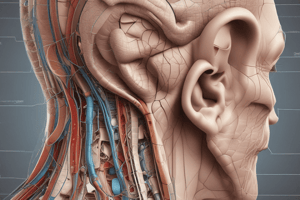Podcast
Questions and Answers
What is the function of the pinna (auricle) in the outer ear?
What is the function of the pinna (auricle) in the outer ear?
- Collects sound waves. (correct)
- Amplifies sound waves.
- Equalizes pressure in the ear.
- Transmits signals to the brain.
Which structure in the middle ear consists of three tiny bones?
Which structure in the middle ear consists of three tiny bones?
- Auditory Nerve
- Eustachian Tube
- Ossicles (correct)
- Cochlea
What does the cochlea do?
What does the cochlea do?
- Maintains balance and spatial orientation.
- Equalizes pressure in the ear.
- Collects sound waves.
- Converts sound vibrations into neural signals. (correct)
Which of the following ear disorders is characterized by ringing in the ears?
Which of the following ear disorders is characterized by ringing in the ears?
How does the vestibular system contribute to ear function?
How does the vestibular system contribute to ear function?
Which practice is recommended to prevent ear infections?
Which practice is recommended to prevent ear infections?
What type of hearing loss occurs due to damage to the auditory nerve?
What type of hearing loss occurs due to damage to the auditory nerve?
What role does the tympanic membrane (eardrum) play in the ear?
What role does the tympanic membrane (eardrum) play in the ear?
Flashcards are hidden until you start studying
Study Notes
Anatomy of the Ear
-
Outer Ear
- Pinna (Auricle): Collects sound waves.
- Auditory Canal: Pathway for sound to reach the eardrum.
- Tympanic Membrane (Eardrum): Vibrates in response to sound waves.
-
Middle Ear
- Ossicles: Three tiny bones (malleus, incus, stapes) that amplify sound vibrations.
- Eustachian Tube: Equalizes pressure between the middle ear and atmosphere.
-
Inner Ear
- Cochlea: Converts sound vibrations into neural signals.
- Vestibular System: Maintains balance and spatial orientation; includes semicircular canals.
- Auditory Nerve: Transmits signals from the cochlea to the brain.
Functions of the Ear
-
Hearing
- Sound waves converted into mechanical vibrations in the middle ear.
- Vibrations translated into electrical signals in the cochlea.
-
Balance
- Inner ear structures detect head position and movement.
- Sends information to the brain to help maintain equilibrium.
Common Ear Disorders
- Otitis Media: Middle ear infection, often affecting children.
- Hearing Loss: Can be conductive (problem with sound transmission) or sensorineural (damage to inner ear or auditory nerve).
- Tinnitus: Perception of noise or ringing in the ears without external sound.
- Meniere's Disease: Inner ear disorder causing vertigo, tinnitus, and hearing loss.
Ear Care Tips
- Regular Check-ups: Annual hearing tests recommended, especially for those at risk.
- Avoid Loud Noises: Use ear protection in loud environments.
- Keep Ears Dry: Prevent infections by avoiding excess moisture.
- Do Not Insert Objects: Avoid using cotton swabs or other objects in the ear canal.
Anatomy of the Ear
- Outer Ear includes the Pinna (Auricle), which collects sound waves, and the Auditory Canal, serving as a pathway for sound to the eardrum.
- Tympanic Membrane (Eardrum) vibrates upon receiving sound waves, facilitating sound transmission to the middle ear.
- Middle Ear houses the Ossicles (malleus, incus, stapes), three small bones that amplify sound vibrations.
- Eustachian Tube functions to equalize pressure between the middle ear and the external environment.
- Inner Ear contains the Cochlea, responsible for converting sound vibrations into neural signals.
- Vestibular System includes semicircular canals, essential for maintaining balance and spatial orientation.
- Auditory Nerve transmits auditory signals from the cochlea to the brain, allowing sound perception.
Functions of the Ear
- Hearing involves the conversion of sound waves into mechanical vibrations in the middle ear, which are then transformed into electrical signals by the cochlea.
- Balance is achieved through inner ear structures that detect head position and movement, sending crucial information to the brain for equilibrium maintenance.
Common Ear Disorders
- Otitis Media is a prevalent middle ear infection that primarily impacts children.
- Hearing Loss may be classified as conductive (issues with sound transmission) or sensorineural (damage to the inner ear or auditory nerve).
- Tinnitus refers to the sensation of noise or ringing in the ears without any external sound source present.
- Meniere's Disease is an inner ear condition characterized by vertigo, tinnitus, and hearing loss.
Ear Care Tips
- Regular Check-ups are advisable, with annual hearing tests particularly recommended for individuals at risk.
- Avoid Loud Noises by using ear protection in environments with high sound levels to prevent hearing damage.
- Keep Ears Dry to minimize infection risks by avoiding excessive moisture exposure.
- Do Not Insert Objects into the ear canal, such as cotton swabs, to prevent damage and blockage.
Studying That Suits You
Use AI to generate personalized quizzes and flashcards to suit your learning preferences.





